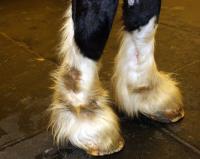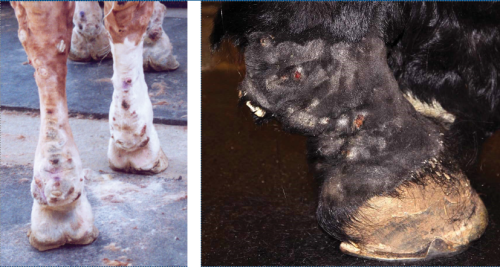Scratches
A Problem No Matter What You Call It

Pastern dermatitis, also known as scratches, greasy heel, mud fever, mud rash, cracked heels, and dew poisoning, has been well documented in horses since the early 1800s. It is commonly characterized by inflammation of the skin on the back of the pastern(s). Regardless of which name is used, most horse handlers will likely have to deal with it at some point. It is important to note that what can start as a minor skin annoyance can become a painful chronic condition if not treated properly.
Horses with pastern dermatitis usually exhibit multiple lesions in the pastern area. Initially, patchy red skin (erythema), oozing, crusting, erosions, and ulcerations develop, followed by swelling (edema) of the affected limb(s). The skin can be itchy and sensitive. Lameness is observed in some cases and can become severe.
Although pastern dermatitis can occur in any horse breed, it is most common in draft breeds and others with heavy feathering on the lower legs that can trap moisture. Horses with white legs are also more susceptible as unpigmented skin is sensitive to sun damage.
It's Complicated

Pastern dermatitis is a clinical descriptive term for a disease complex that can be triggered by different causes. These can include environmental factors, allergies, drug reactions, fungi, bacteria, parasites and sunlight-induced vascular changes of white legs. Extended exposure to moisture, in the form of wet bedding, muddy pastures, etc., seems to be a common cause or perpetuating factor. Bacterial infections typically develop due to damaged skin barrier. Underlying genetic components are considered for draft horses with chronic progressive lymphedema.
As there are many potential causes for pastern dermatitis, there are also a number of possible treatments. Diagnosis is based on biopsy for histopathology and bacterial and fungal cultures, but antibiotic therapy, accompanied by clipping and mildly cleansing the affected area (with topical corticosteroid application if one week of this has shown no improvement), is acceptable initially. Trimethoprim-sulfa antibiotics, corticosteroids, and/or resolution or control of the underlying disease process are the most common treatment modalities. In some cases, avoiding sun exposure may be helpful. Early, accurate diagnosis and appropriate treatment result in the most successful outcomes and prevention of severe chronic changes.
An Ounce of Prevention
Prevention of pastern dermatitis generally relies on avoiding exposure of the area to recurrent moisture. This includes limiting turnout of horses in wet grass or muddy pastures, drying the pastern areas well after bathing, keeping hair clipped on the lower legs, and avoiding long-term use of boots and wraps that can trap moisture. Proper stable hygiene, including providing clean, dry bedding, is essential for preventing pastern dermatitis and other health and welfare issues.
Chronic Progressive Lymphedema
Chronic progressive lymphedema (CPL) is a debilitating condition caused by a buildup of lymph fluid (lymphedema) in the lower legs that results in progressive swelling. Over time, the swelling becomes firm and is associated with skin folds, nodules and ulcerations. It has been described in several draft breeds, as well as Friesians and Gypsy Vanners. Since affected horses typically develop secondary recurrent bacterial and/or parasitic pastern dermatitis, CPL is often erroneously referred to as “chronic pastern dermatitis.” However, CPL is the underlying condition, which worsens with each recurrence of pastern dermatitis.
There is currently no successful permanent treatment for CPL. Careful management, supportive therapy and avoidance of secondary infections can improve the quality of life for affected horses. This involves antibiotics to treat secondary bacterial infections, antiparasitic treatments to avoid reinfestation with Chorioptes mites, keeping the feathers clipped short, daily exercise, routine foot, ergot and chestnut trimming, daily hoof cleaning, and combined decongestive therapy (CDT). The latter is very helpful and includes manual lymph drainage massage and compression bandaging; both must be applied correctly and should only be performed by professionals. Horses should be kept in dry environments and pesticide applications may be required in barns to minimize mite infestations. These treatments are labor-intensive and must be maintained for the life of the horse to minimize discomfort, slow the progress of the disease, avoid recurrent infections, and ensure quality of life.
Researchers hypothesize that CPL is multifactorial. The wide distribution within each of the affected breeds suggests an underlying genetic component. “Several attempts to identify genetic factors of CPL have not been successful to date,” said Dr. Verena Affolter, a dermatopathologist at the UC Davis veterinary hospital who studies CPL together with Dr. Danika Bannasch, a geneticist at UC Davis. “As such, there is currently no clear path to prevent the disease in susceptible breeds.” Due to the late age of onset, many horses are bred prior to diagnosis, thereby passing any genetic predisposition to future generations.

